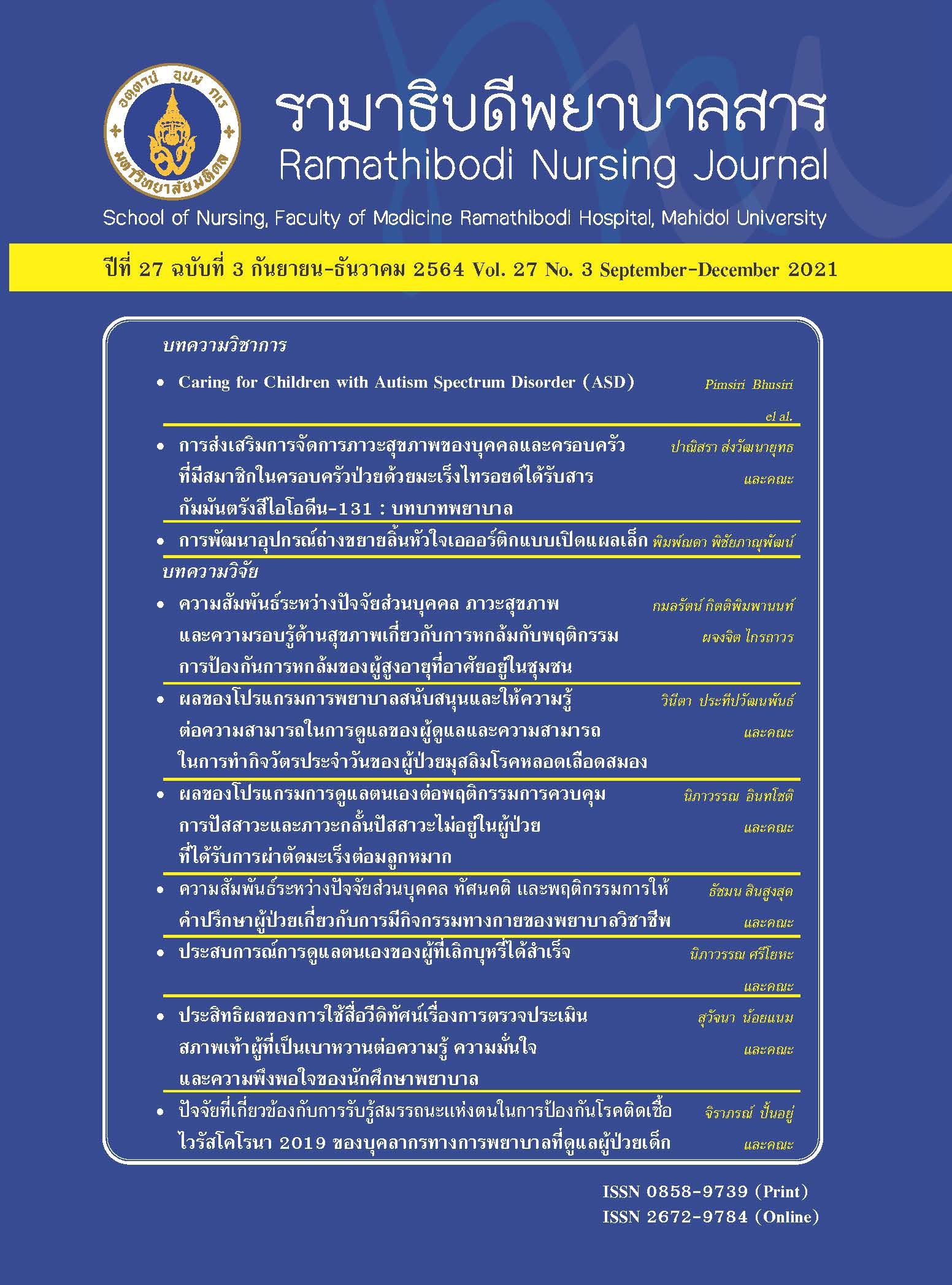Relationships between Personal Factors, Attitude, and Physical Activity Counseling Behaviors in Professional Nurses
Main Article Content
Abstract
This correlational research aimed to examine the relationship between nurses’personal factors, attitude towards physical activity, and physical activity counseling behaviors to their patients. The sample included 74 nurses in the outpatient department in a university hospital. The instruments used in the study were the questionnaires to elicit demographic data, attitude towards physical activity, and physical activity
counseling behaviors. Data were analyzed using descriptive statistics and Pearson’s product-moment correlation coefficient. The results revealed that all participants were female with a mean age of 38.15 years and the median of work experience was 13 years. Half of them had normal body mass index (BMI) and had no underlying diseases.The majority of their physical activity behaviors were exercised sometimes. Nurses had an attitude towards physical activity at a high level, but their physical activity counseling behaviors were low. The frequency of exercise was positively associated with counseling behaviors. However, age, work experience, BMI, and attitude were not significantly associated with physical activity counseling behaviors. The results serve as information for the administrators to broaden scopes of nursing practice in line with the goal of the Thai National Health Development Plan. Moreover, employers should support the health
promotion program for employees to increase their physical activity level and realize physical activity as part of the health promotion and treatment program for clients.
Keywords: Counseling behaviors, Physical activity, Attitude towards physical activity,
Professional nurses
Article Details
บทความ ข้อมูล เนื้อหา รูปภาพ ฯลฯ ที่ได้รับการตีพิมพ์ในรามาธิบดีพยาบาลสาร ถือเป็นลิขสิทธิ์ของวารสาร หากบุคคลหรือหน่วยงานใดต้องการนำทั้งหมดหรือส่วนหนึ่งส่วนใดไปเผยแพร่หรือเพื่อกระทำการใด ใด จะต้องได้รับอนุญาตเป็นลายลักษณ์อักษรจากรามาธิบดีพยาบาลสารก่อนเท่านั้น
References
World Health Organization (WHO). Global action plan on physical activity 2018–2030: more active people for
a healthier world; 2018. Available from website: https://www.who.int/publications/i/: item/9789241514187
Strategy and Planning Division Ministry of Public Health 2018; 2018. Available from website: http://bps.moph.
go.th/new_bps/sites/default/files/statistic61%20full.pdf (in Thai)
U.S. Department of Health and Human Services. Physical activity guidelines for Americans 2nded. [cited 2019
October 27]. Available from: https://health.gov/paguidelines/second- edition/pdf/ Physical_Activity_
Guidelines_2nd_edition.pdf
Ribeiro MA, Martins MA, Carvalho CRF. The role of physician counseling in improving adherence to physical
activity among the general population. Sao Paulo Med J.2007;125(2):115-21. doi: 10.1590/s151 31802007000200010.
National Economic and Social Development Board Office of the Prime Minister. The twelfth national economic and social development plan (2017-2021); 2019. Available from website: https://wops.moph.go.th/ops/oic/
data/20161115144754_1_.pdf (in Thai)
Pinto BM, Goldstein MG, Marcus BH. Activity counseling by primary care physicians. Prev Med. 1998;27(4):506-13.
Frank E, Tong E, Lobelo F, Carrera J, Duperly J. Physical activity levels and counseling practices of U.S. medical
students. Med Sci Sports Exe. 2008; 40(3): 413-21.
The promotion of physical activity and health development board. Thailand 2018-2030 national physical activity
plan; 2018. Available from website: http://dopah.anamai moph go.th/wp-content/uploads/2018/07/Physical-
Activity-Plan.pdf (in Thai)
Buchholz SW, Purath J. Physical activity and physical fitness counseling patterns of adult nurse practitioners. J
Am Acad Nurse Pract. 2007;19(2):86-92.
Grimstvedt ME, Der Ananian C, Keller C, Woolf K, Sebren A, Ainsworth B. Nurse practitioner and
physician assistant physical activity counseling knowledge,confidence and practices. Prev Med. 2012;54(5):306-8.
Carroll JK, Fiscella K, Epstein RM, Sanders MR, Williams GC. A 5A’s communication intervention to promote
physical activity in underserved populations. BMC Health Serv Res. 2012;12:374. doi: 10.1186/1472-6963-
-374.
Whitlock EP, Orleans CT, Pender N, Allan J. Evaluating primary care behavioral counseling interventions: an
evidence-based approach. Am J Prev Med. 2002;22:267-84.
Jay M, Schlair S, Caldwell R, et al. From the patient’s perspective: the impact of training on resident physician’s obesity counseling. J Gen Intern Med. 2010;25:415-22.
Utap MS, Tan CPL, Su AT. Effectiveness of a brief intervention for smoking cessation using the 5A model
with self-help materials and using self-help materials alone: a randomized controlled trail. Malays Fam
Physician. 2019;14(2):2-9.
Sirisopon D, Leewanun C, Kuptniratsaikul V. The attitudes and behavior of exercise of residents of Faculty of
Medicine, Siriraj Hospital. ASEAN J Rehabil Med.2011;21(2):50-5. (in Thai)
Lawlor DA. and Hanratty B. The effect of physical activity advice given in routine primary care consultation: a
systematic review. J Public Health Med. 2001;23(3):219-26.
Esposito EM. and Fitzpatrick JJ. Registered nurses’ beliefs of the benefits of exercise, their exercise behavior and their patient teaching regarding exercise. Int. J. Nurs.2011;17:351-6.
Pender NJ, Murdaugh CL, Parson MA. Health promotion in nursing practice. 5thed. California: Prentice-Hall; 2006.
Ajzen I. The theory of planned behavior. Organ Behav Hum Decis Process. 1991;50(2):179-211.
American College of Sports Medicine. ACSM’s guidelines for exercise testing and prescription.9thed. Philadelphia:Two Commerce Square; 2014.
Lin ML, Huang JJ, Chaung HY, Tsai HM, Wang HH.Physical activities and influencing factors among public
health nurses: a cross-sectional study. BMJ.2018;8(4):e019959. doi: 10.1136/bmjopen-2017-019959
Walsh LM, Callaghan HP, Keaver LM. Physical activity knowledge attitudes and behaviors among Irish nursing
students. Int J Health Promot Educ. 2020; 59(3):1-11.doi:10.1080/14635240.2020.1729221
Bowen PG Mankowski RT, Harper SA, Buford TW.Exercise is medicine as a vital sign: challenges and
opportunities. Transl J Am Coll Sports Med. 2019;4(1):1-7.
Barnes PM, Schoenborn CA. Trends in adults receiving a recommendation for exercise or other physical activity from a physician or other health professional. NCHS Data Brief. 2012;(86):1-8.
Pukrittayakamee P, Busssaratid S, Hosiri T, Wannarit K.Use of 5 A’s model for smoking-cessation by residents in Siriraj hospital. Journal of Psychiatric Association of Thailand. 2017;62(2):157-66. (in Thai)
AuYoung M, Linke SE, Pagoto S, Buman MP, Craft LL,Richardson CR, et al. Integrating physical activity in
primary care practice. Am J Med. 2016;129(10): 1022-9. doi: 10.1016/j.amjmed.2016.02.008
Abramson S, Stein J, Schaufele M, Frates E, Rogan S.Personal exercise habits and counseling practices of
primary care physicians: a national survey. Clin J Sport Med. 2000;10(1):40-8. doi: 10.1097/00042752-
-00008
McCarty MC, Hennrikus DJ, Lando HA, Vessey JT.Nurses’ attitudes concerning the delivery of brief cessation
advice to hospitalized smokers. Prev Med. 2001;33(6):674–81. doi: 10.1006/pmed.2001. 0944
Bakhshi S, Sun F, Murrells T, While A. Nurses’ health behaviours and physical activity-related health-promotion practices. Br J Community Nurs. 2015;20(6):289-96.doi: 10.12968/bjcn.2015.20.6.289


